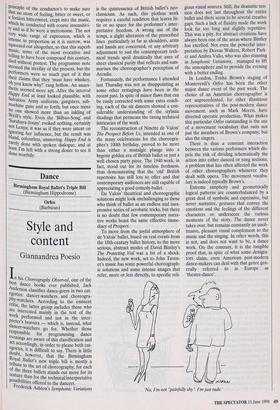Dance
Birmingham Royal Ballet's Triple Bill (Birmingham Hippodrome) Orfeo (Barbican)
Style and content
Giannandrea Poesio
In his Choreography Observed, one of the best dance books ever published, Jack Anderson classifies dance-goers in two cat- egories: dancer-watchers and choreogra- PhY-watchers. According to the eminent critic, the latter group includes those who are interested mainly in the text of the work performed and not in the inter- preter's bravura — which is, instead, what dancer-watchers go for. Whether those responsible for programming dance evenings are aware of this classification and act accordingly, in order to please both cat- egories, it is difficult to say. There is little doubt, however, that the Birmingham Royal Ballet's new triple bill is mostly a tribute to the art of choreography, for each of the three ballets stands out more for its texture than for the technical/interpretative possibilities offered to the dancers. Frederick Ashton's Symphonic Variations is the quintessence of British ballet's neo- classicism. As such, this plotless work requires a careful rendition that leaves lit- tle or no space for the performer's inter- pretative freedom. A wrong use of the tempi, a slight alteration of the prescribed lines particularly as far as shoulders, arms and hands are concerned, or any arbitrary adjustment to suit the contemporary tech- nical trends spoil drastically that aura of sheer classical purity that reflects Sand sum- marises the choreographer's perception of Arcadia.
Fortunately, the performance I attended last Thursday was not as disappointing as some other restagings have been in the recent past. In spite of minor flaws that can be easily corrected with some extra coach- ing, each of the six dancers showed a con- siderable understanding of the stylistic shadings that permeate the taxing technical intricacies of the work.
The reconstruction of Ninette de Valois' The Prospect Before Us, intended as one of the many celebrations for the choreogra- pher's 100th birthday, proved to be more than either a nostalgic plunge into a bygone golden era of British ballet or just a well chosen party piece. The 1940 work, in fact, stood out for its timeless freshness, thus demonstrating that the 'old' British repertoire has still lots to offer and that contemporary audiences are still capable of appreciating a good comedy-ballet.
De Valois' theatrical and choreographic solutions might look unchallenging to those who think of ballet as an endless and inex- pressive series of acrobatic tricks, but there is no doubt that few contemporary narra- tive works boast the same effective imme- diacy of Prospect.
To move from the joyful atmosphere of de Valois' ballet, based on real events from the 18th-century ballet history, to the more serious, abstract modes of David Bintley's The Protecting Veil was a bit of a shock. Indeed, the new work, set to John Taven- er's music has some powerful choreograph- ic solutions and some intense images that refer, more or less directly, to specific reli- gious visual sources. Still, the dramatic ten- sion does not last throughout the entire ballet and there seem to be several creative gaps. Such a lack of fluidity made the work look far too long and slightly repetitive.
This was a pity, for abstract creations have always been one of the areas where Bintley has excelled. Not even the powerful inter- pretation by Dorcas Walters, Robert Park- er and Ambra Vallo, who was also stunning in Symphonic Variations, managed to lift the atmosphere and to provide the evening with a better ending.
In London, Trisha Brown's staging of Monteverdi's Orfeo has been the other major dance event of the past week. The choice of an American choreographer is not unprecedented, for other illustrious representatives of the post-modern dance movement, such as Mark Morris, have directed operatic production. What makes this particular Orfeo outstanding is the use of a movement vocabulary that suits not just the members of Brown's company, but also the singers.
There is thus a constant interaction between the various performers which dis- pels the risk of dividing schematically the action into either danced or sung sections, a problem that has often affected the work of other choreographers whenever they dealt with opera. The movement vocabu- lary is indeed typically Brown's.
Extreme simplicity and geometrically logical patterns are counterbalanced by a great deal of symbolic and expressive, but never narrative, gestures that convey the emotions and the feelings of the different characters or underscore the various moments of the story. The dance never takes over, but remains constantly an unob- trusive, pleasant visual complement to the music and the singing. In other words, this is not, and does not want to be, a dance work. On the contrary, it is the tangible proof that, in spite of what some denigra- tors claim, even American post-modern dance-makers can deal with that genre gen- erally referred to in Europe as `theatre-dance'.
No, I'm not "painfully shy". I'm just rude.'


































































 Previous page
Previous page